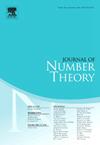Ring class fields and a result of Hasse
IF 0.6
3区 数学
Q3 MATHEMATICS
引用次数: 0
Abstract
For squarefree , let M denote the ring class field for the order in . Hasse proved that 3 divides the class number of F if and only if there exists a cubic extension E of such that E and F have the same discriminant. Define the real cube roots and , where is the fundamental unit in . We prove that E can be taken as if and only if . As byproducts of the proof, we give explicit congruences for a and b which hold if and only if , and we also show that the norm of the relative discriminant of lies in or according as or . We then prove that v is always in the ring class field for the order in F. Some of the results above are extended for subsets of properly containing the fundamental units .
环类字段和哈塞结果
对于无平方 d>1,让 M 表示 F=Q(-3d) 中阶 Z[-3d] 的环类域。哈塞证明,当且仅当存在一个 Q 的立方扩展 E,使得 E 和 F 具有相同的判别式时,3 平分 F 的类数。定义实立方根 v=(a+bd)1/3 和 v′=(a-bd)1/3,其中 a+bd 是 Q(d) 的基本单位。我们证明,当且仅当 v∈M 时,E 可以看作 Q(v+v′)。作为证明的副产品,我们给出了 a 和 b 的明确同余式,当且仅当 v∈M 时,这两个同余式成立,我们还证明了 F(v)/F 的相对判别式的规范位于{1,36}或{38,318},视 v∈M 或 v∉M 而定。然后,我们证明 v 总是在 F 的阶 Z[-27d] 的环类域中。上面的一些结果可以扩展到适当包含基本单元 a+bd 的 Q(d) 子集。
本文章由计算机程序翻译,如有差异,请以英文原文为准。
求助全文
约1分钟内获得全文
求助全文
来源期刊

Journal of Number Theory
数学-数学
CiteScore
1.30
自引率
14.30%
发文量
122
审稿时长
16 weeks
期刊介绍:
The Journal of Number Theory (JNT) features selected research articles that represent the broad spectrum of interest in contemporary number theory and allied areas. A valuable resource for mathematicians, the journal provides an international forum for the publication of original research in this field.
The Journal of Number Theory is encouraging submissions of quality, long articles where most or all of the technical details are included. The journal now considers and welcomes also papers in Computational Number Theory.
Starting in May 2019, JNT will have a new format with 3 sections:
JNT Prime targets (possibly very long with complete proofs) high impact papers. Articles published in this section will be granted 1 year promotional open access.
JNT General Section is for shorter papers. We particularly encourage submission from junior researchers. Every attempt will be made to expedite the review process for such submissions.
Computational JNT . This section aims to provide a forum to disseminate contributions which make significant use of computer calculations to derive novel number theoretic results. There will be an online repository where supplementary codes and data can be stored.
 求助内容:
求助内容: 应助结果提醒方式:
应助结果提醒方式:


